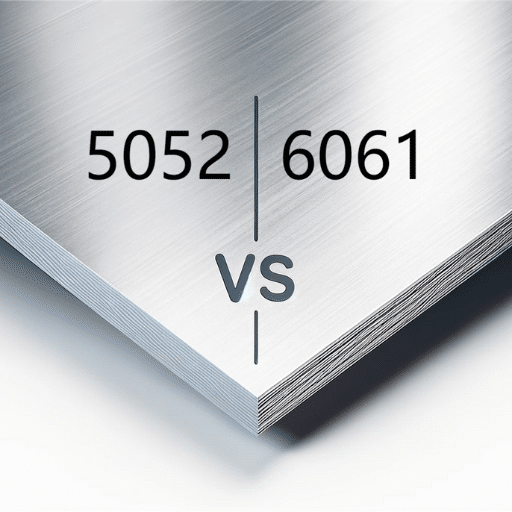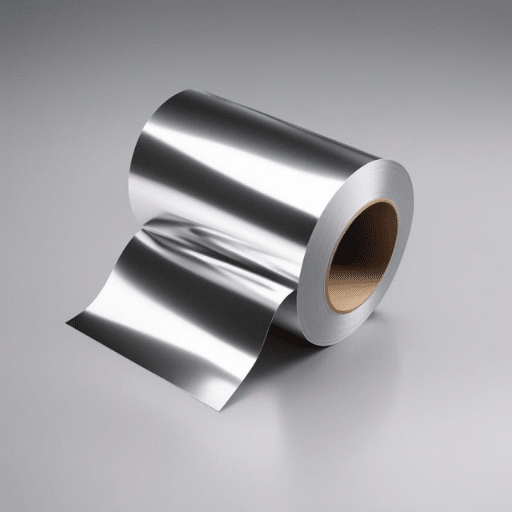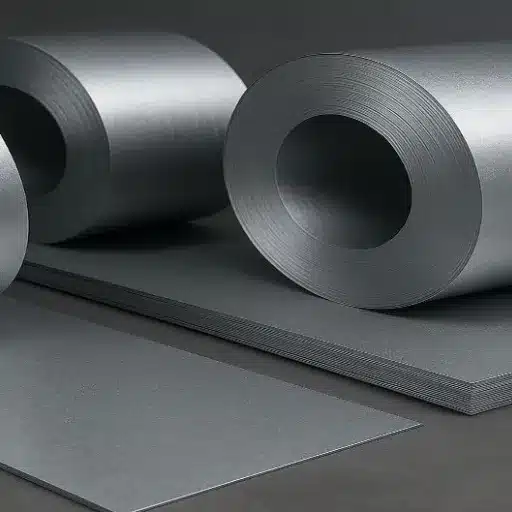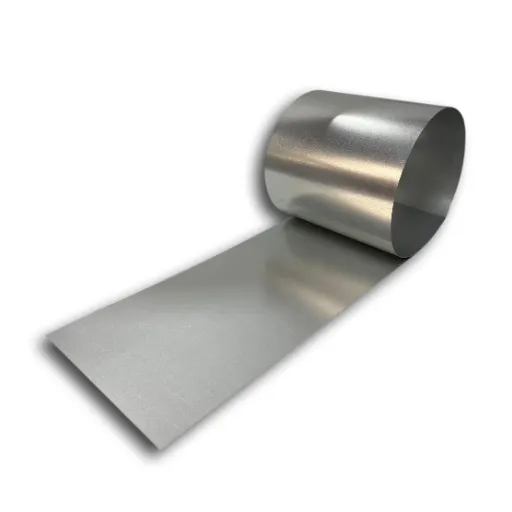The handling and preparation of food is a complex, multidisciplinary field that requires hygiene and safety for food-grade stainless steel processes. Sanitary stainless steel, an innovative technology specially created for the food and beverage sector, is the center of all these considerations. This article will look into the domain of food grade stainless steel processing, its distinct characteristics, its hygiene maintenance role, and examine why it becomes the basis for safe and ideal food sanitary grade stainless steel production. This guide is for you, whether you are an engineer, a manufacturer, or just want to know how food safety is maintained.
What Defines Sanitary Grade Stainless Steel?
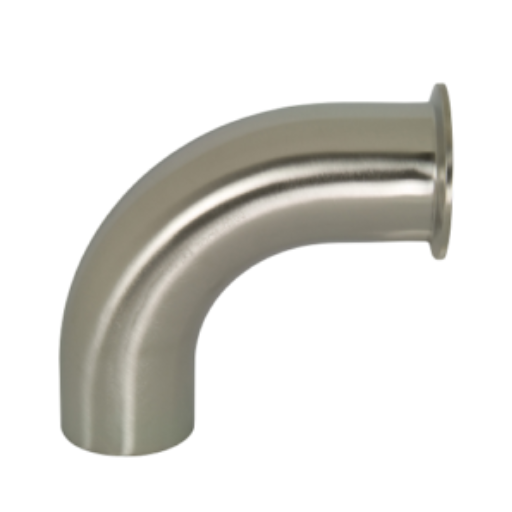
Its strict hygiene and cleanliness standards define sanitary-grade stainless steel. It is very easy to clean, highly resistant to corrosion, and durable, which makes it ideal for food production and healthcare. Usually, this type of stainless steel contains a smooth, non-porous surface that inhibits bacteria or contaminant buildup. For sanitary purposes, common stainless grades used include 304 and 316 stainless steel due to their strength and resistance to moisture and chemical exposure.
Chemical Composition and Material Grades That Make Stainless Steel “Sanitary”
The properties of sanitary stainless steel are derived from the balance of its chemical composition. For 304 and 316 grades, the chromium content is high, around 18 to 20% for 304 and 16 to 18% for 316. Chromium does passivation, forming an oxide layer on the stainless steel surface, which gives it corrosion resistance.316 grade also has 2 to 3% molybdenum, which increases the resistance towards chlorides and harsh cleaning solvents, making it suitable for food processing or medical equipment.
Nickel, which is present in 8 to 12% of 304 and 10 to 14% of 316, also improves the resistance to oxidation, increases the toughness, and makes the steel more ductile. The low-carbon versions of these steels, 304L and 316L, are used for fabrication by welding or in high humidity environments where lower carbon means less carbide precipitation, which could affect corrosion resistance.
These material grades also undergo additional scrutiny in the form of ISO compliance and other international standards, which ensures that roper hygiene and safety standards are met. These certifications ensure that the stainless steel can withstand multiple cycles of sterilization without getting damaged or having unwanted residue on the surface, which is crucial for sanitary environments.
ASTM A270 and ASME Standards for Sanitary Stainless Steel
The requirements for seams and welded austenitic and ferritic stainless steel sanitary tubing are detailed under the ASTM A270 specification. Sanitary tubes are of special concern to food, beverage, and pharmaceutical processing industries, which require the highest hygienic sanitation. The specification includes tolerances for some of the dimensions, such as the surface finish and the mechanical properties. In typical applications, internal surface roughness (Ra) of the tubing is less than 20 micrometers, and for some specialized applications, it may be even lower to facilitate cleaning and sanitation processes.
Other ASME standards, such as those in the BPE (BioProcessing Equipment) series, address other components that are used in the biopharmaceutical industry and complement ASTM A270. For instance, ASME BPE ensures that the installed stainless steel piping systems are maintained at the prescribed standards of purity and durability. The standards focus on post-fabrication processes such as the control of welds, minimizing bacterial crevice borders, and achieving required electropolished surfaces, wherein the roughness of the surface is frequently 15 micro inches or less for bioprocessing purposes.
The standards still pay attention to corrosion resistance, durability, and cleanability, which makes stainless steel an appealing material for sanitary applications. Compliance with the standards is confirmed through highly detailed examinations, which include but are not limited to dimensional analysis, roughness measurements, and pressure testing. These collectively guarantee that sanitary stainless steel tubing functions adequately under important conditions.
Surface Finish Requirements for Sanitary Applications
The surface finish of stainless steel tubes used in sanitary applications is important to maintain hygiene and prevent contamination. Regulations such as ASME BPE and ASTM A270 set requirements on the degree of roughness (Ra) to reduce the chances of microbial buildup on surfaces, which is usually required. For instance, there is a commonly required Ra of 0.5 µm (20 µin) or better for the internal surface of sanitary tubing, depending on the use.
To meet these requirements, corrosion polishing is often used, which increases the smoothness and strengthens the corrosion resistance of the tubing by removing surface irregularities microscopically. Moreover, passivation treatments are applied to form a uniform chromium-oxide film on the surface, enhancing the tubing’s corrosion resistance. These technologies not only maintain cleanliness, but also fulfill legal and industrial obligations which transcend the food and pharmaceutical Industries, or biotechnology. Compliance is ensured through rigorous inspection and testing to guarantee standards are met.
What Are the Different Types of Sanitary Grade Stainless Steel?
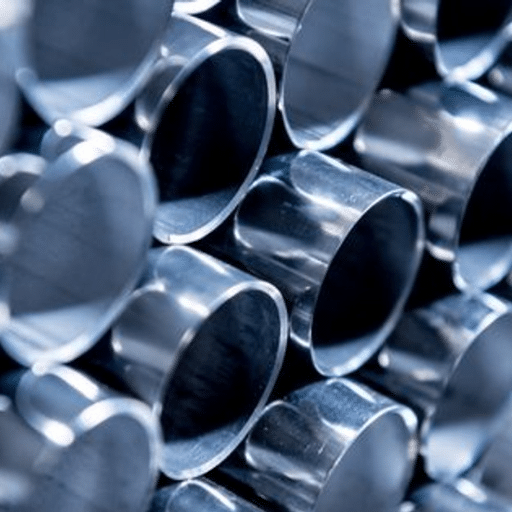
Sanitary grade stainless steel primarily contains types 304 and 316.
Type 304: This is the most common grade, which has exceptional corrosion resistance and works well for basic sanitary applications. It is abundantly applied in food processing and kitchen equipment.
Type 316: This has added molybdenum, which increases its corrosion resistance, especially for chlorides and acids. This makes it more suitable for harsher environments like pharmaceuticals and biotechnological fields.
These grades were selected because of their resistance to corrosion, sanitation, and hygiene requirements.
304 vs 316L Stainless Steel for Sanitary Applications
While comparing 304 and 316L stainless steels for use in sanitary applications, several considerations come to mind. Following is an elaborate comparison on their properties, applications, and appropriateness for specific environments:
- Corrosion Resistance:Type 304: Has exceptional corrosion resistance for many different environments, although less effective for chlorides and highly acidic conditions.Type 316L: Exhibits greater resistance to corrosion because of the molybdenum content, making it ideal for harsher environments with chlorides or chemicals.
- Chemical Composition:Type 304: Contains roughly 18-20% of chromium and 8-10.5% of nickel.Type 316L: Contains approximately 16-18% of chromium and 10-14% of nickel, in addition to 2-3% of molybdenum, further improving its corrosion resistance properties.
- Cost:Type 304: It is the most readily available and most economical due to its common use in general applications.Type 316L: Increased cost due to additional alloying elements, but suited for demanding applications where longevity and performance are critical.
- Strength and Durability:Both perspectives provide a near-equal level of strength and durability regarding performance efficiency against wear and tear over long periods.
- HygieneBoth 304 and 316L are appropriate for sanitary use due to their exceptional cleanliness. Contaminating chemicals might be more of a concern for 316L, so it might be preferred in some cases.
- Applications:Type 304: Utilized in food processing equipment, kitchen appliances, and general sanitary equipment.Type 316L: Used in pharmaceutical, biotechnology, and chemical processing industries that face severe corrosion and pitting in extreme environments.
Through these considerations, industries can make rational choices when choosing stainless steel grades for sanitary applications. Type 316L performs markedly better in corrosive and demanding settings, while Type 304 is more cost-effective and multi-functional.
Austenitic Stainless Steel Properties for Food and Beverage
Austenitic stainless steels such as types 304 and 316L are well-known in the food and beverage industry for their excellent properties, meeting the industry’s stringent requirements. These grades ensure high corrosion resistance, meaning they will not damage food products or introduce contaminants. The chromium in Type 304, which is approximately 18-20% and increases in Type 316L with molybdenum, giving strong resistance to oxidation even in moist and acidic environments.
Another great feature of austenitic stainless steel is its smooth and non-porous surfaces. It allows easy cleaning and maintenance of hygiene standards and helps prevent the buildup of bacteria, making it suitable for food processing equipment. Type 304, popularly referred to as “food grade stainless steel,” is widely used in the manufacture of utensils, storage tanks, and food prep tables. Type 316L is better suited for processing salty and acidic foods and beverages like sauces, marinades, or specialized drinks due to its added resistance to chemicals and chlorides.
Furthermore, austenitic stainless steels withstand very high and low temperatures. They maintain their mechanical characteristics in elevated and sub-zero temperatures, permitting machinery such as pasteurizers and cryogenic freezers to function effectively. Moreover, these grades have excellent toughness alongside high resistance to abrasion, minimizing the maintenance burden and extending the service life of the equipment.
Because of these characteristics, austenitic stainless steels become fundamental in the food and beverage industry, as well as ensuring the sector remains eco-friendly and meets international safety regulations.
Corrosion Resistance Factors in Sanitary Stainless Steel
The notable corrosion resistance of sanitary stainless steel is due to the presence of chromium, which ranges from 16% to 18% in most austenitic grades like 304 and 316. The chromium will react with oxygen in the environment and create an oxide layer of chromium on the surface, which protects it from further oxidation and corrosion.
In grade 316 stainless steel, molybdenum increases the resistance to pitting and crevice corrosion (2-3%). Molybdenum is particularly useful in areas that have chloride ions, such as saltwater and some cleaning agents. Nickel also increases the toughness of the metal and contributes to its resistance towards chemicals that are aggressive in nature, which is common when cleaning food and beverage equipment.
Corrosion resistance is also affected by temperature. Research indicates that stainless steel can withstand high-temperature sanitization processes without surface damage. For example, grade 304 can occasionally go up to 870 degrees Celsius, and grade 316 can go beyond 900 degrees Celsius. These properties of the material make it ideal for thermal processes and chemical sterilization in manufacturing facilities.
Finally, achieving and upholding desired surface smoothness and proper cleaning regimens play an important role in maximizing corrosion resistance. Finishes above 0.8 µm Ra in roughness will greatly reduce the chances of any surface contaminants muting polished material performance, which in turn enhances material hygiene ratings.
How Is Sanitary Stainless Steel Tubing Manufactured?
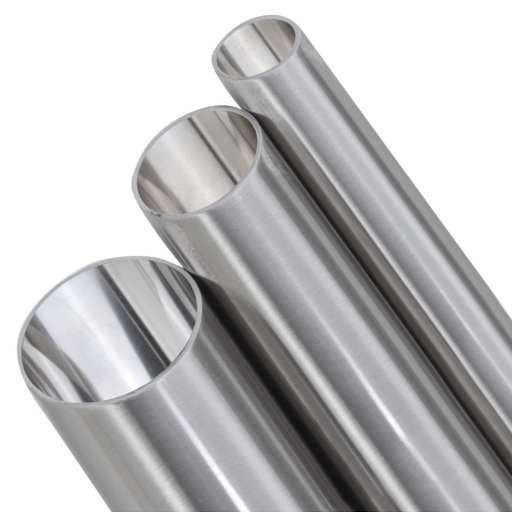
The steps involved in the creation of sanitary stainless steel tubing include a meticulous method of producing the tubing with high durability and specific cleanliness. These steps include the following:
- Material Selection: Selecting the highest grade of stainless steel for its resistive properties towards corrosion and for its usability in sanitary applications.
- Forming: Tubular shapes of stainless steel are rolled, and the basic tubing structure is welded.
- Heat Treatment: Improvement of mechanical properties and uniformity of the tubing is achieved through heat treatment.
- Surface Finishing: Polishing of inner and outer surfaces to the smoothest of rougness, lowering it to 0.8 µm Ra, greatly reduces the risk of contamination.
- Cleaning and Inspection: Rigorous quality and thorough cleansing inspections, checking for dimensional accuracy along with hygiene standards, are also put in place for the tubing.
Manufacturing procedures are enhanced for the strict requirements of preparing the tubing for the pharmaceutical and food industries.
Welded Sanitary Tubing Production Process
I would articulate the process of Welded Sanitary Tubing Production as a well-defined process emphasizing accuracy and cleanliness. It includes the careful selection of raw materials, polishing to a smooth finish, and advanced welding techniques to form the tubing. Clean tubing is then inspected and scrubbed to ensure that it is clean enough to be used in the food, beverage, and pharmaceutical industries, among others.
OD and Wall Thickness Specifications for Sanitary Stainless Steel Tubes
The process of producing sanitary stainless steel tubing involves several fabrication steps, markedly sophisticated to enhance and prolong its cleansing efficacy alongside structural integrity.
Materials Selection: The chosen grade of stainless steel composes the tubing due to its anti-corrosive features and compatibility with sanitary grade applications.
Forming: The tubing’s base structure is cast by rolling the stainless steel into a tubular shape and welding it.
Heat Treatment: Some parts of the tubing’s structure that need improvement are also color tempered; this helps reinforce the mechanical properties and strengthen uniformity.
Surface Finishing: In a bid to at least mitigate contamination risk, polishing to the smoothest possible finish at the inner and outer surfaces of the tubing is done, often up to 0.8µmrA or lower.
Inspection and Cleaning: Rigorous cleaning, as well as a series of quality inspections that include checking the pre-set sanitary design standards, claim needs to be met, in addition to testing the internal and external dimensions for accuracy, is also done.
With regards to these careful steps, the sanitary steel tubing created meets the strict requirements needed in the food, beverage, and pharmaceutical industries.
Quality Control in Sanitary Tube Manufacturing
Quality control ensures that sanitary tubes fulfill all relevant requirements and standards. This encompasses a whole range of checks and tests that must be performed efficiently and thoroughly. For instance, surface finish is also critical as many sanitary tubes require compliance with surface roughness (Ra) hygiene polishing standards of 32 microinches or lower. This requirement is verified by advanced surface analysis instruments such as Profilometers.
Moreover, non-destructive tests such as Ultrasonic or Eddy Current testing are widely used for the detection of internal/external tube defects without compromising its structural integrity. This improves reliability, whereby the final product is ensured of no internal cracks, voids, or external flaws aesthetically, which would cause malfunctions during use. Another important step includes Hydrostatic Pressure Testing, which entails the application of pressurized water to the tube to ascertain its strength and ability to withstand leaks while in functional conditions.
To further assure quality, material certification is often given, which guarantees the tubes are manufactured out of premium stainless steel alloys like 304 or 316L. Both alloys have superb resistance to corrosion and are appropriate for food, pharmaceutical, and biotech uses. These actions collectively guarantee that the sanitary tubes perform reliably and sustain the stringent requirements of hygienic industries.
What Applications Require Sanitary Grade Stainless Steel?
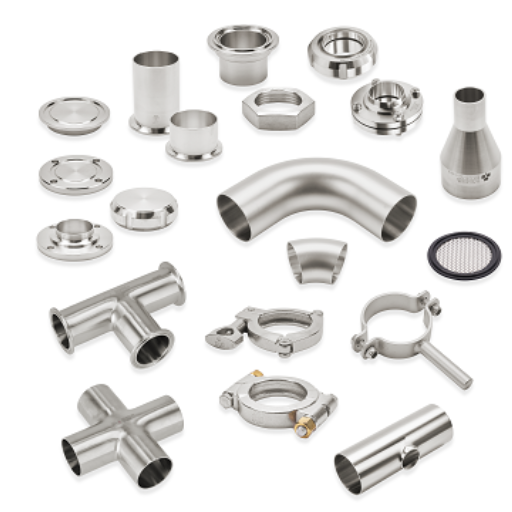
Segments of the food and beverage industry, specifically processing and packaging, as well as the pharmaceutical industry concerned with drug manufacture and delivery systems, and the biotech sector involving laboratory research equipment and research facilities, require a high standard of cleanliness and hygiene. Sanitary grade stainless steel is also used in these fields due to its balance between corrosion resistance and easy cleaning, which preserves safety and contamination-free environments.
Food and Beverage Processing Requirements
The food and beverage industry needs to uphold meticulous standards of hygiene and safety to avoid contamination and protect the health of consumers. Due to its remarkable versatility and properties, stainless steel is among the most prominent materials used in this industry. Additionally, stainless steel must comply with sanitary design requirements such as those set by NSF (National Sanitation Foundation) and 3-A Sanitary Standards, which govern stainless steel appliances.
Stainless steel has many important features out of which corrosion resistance stands out the most. This becomes important when dealing with acidic and alkaline materials present in the food and beverage industry. For instance, the chromium portion of stainless steel helps in forming a protective oxide layer, which prevents rusting, and the equipment can be used for a longer period of time. Furthermore, it’s non-porous and easy to maintain, minimizing the accumulation of bacteria and other minute life forms. Evidence suggests that stainless steel equipment can be cleaned with high-pressure water or steam without structural damage, which is critical during sterilization processes.
Additionally, research indicates that stainless steel, particularly 304 and 316 grades, is favored in processing settings. For example, Grade 316 has molybdenum, which improves salt solution and food prep acid resistance. Such characteristics make stainless steel essential in the dairy industry for pasteurization, meat processing, and bottling beverages.
Pharmaceutical and Bioprocessing Applications
Stainless steel is important in the pharmaceutical and bioprocessing industries because of its excellent hygienic properties and durability. Highlighted below are the attributes and data that emphasize its applications:
- Corrosion Resistance: For pitting and crevice corrosion resistance, 316L stainless steel is ideal for use in aggressive chemical and sterilization processes in pharmaceutical processing
- Surface Finish: Stainless steel can be polished to a smooth, non-porous finish, which minimizes the risk of contamination from microorganisms in strict compliance with FDA and EU laws.
- Chemical Compatibility: Stainless steel is compatible with a variety of cleaners as well as sterilization methods such as high-temperature steam, thus meeting cGMP standards.
- Longevity: Stainless steel equipment can withstand long service periods without incurring frequent replacements, which helps ensure steady production cycles.
- Applications in Cleanrooms:
-
- Due to its sterility, it is utilized in the construction of containment vessels, reaction tanks, and storage tanks.
- Owing to its ease of cleaning, tables, carts, and workstations of cleanroom grade polycarbonates are fabricated.
- Data on Thermal Resistance:
-
- Stainless steel’s structural integrity is maintained at elevated temperatures during sterilization processes like autoclaving, which operates between 121°C 134 134°C.
- Resistance to Contamination:
-
-
High chromium content (min 16%) prevents contamination in sensitive biotechnological and pharmaceutical processes by forming a protective oxide layer.
-
This alloy of iron and chromium with other elements provides great usefulness in bioprocessing systems as it ensures safety, efficiency, and adheres to strict standards of the industry.
How Do Sanitary Fittings Work with Stainless Steel Tubing?
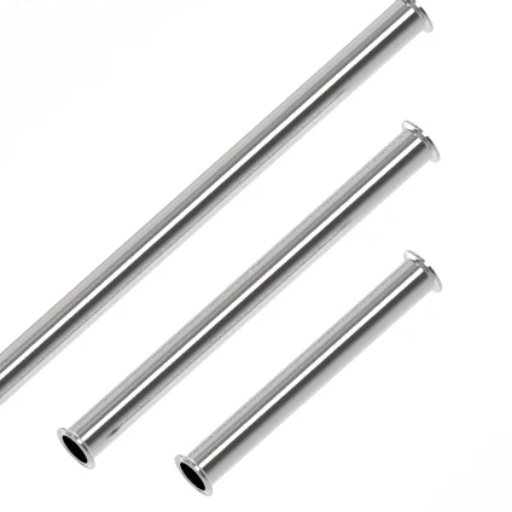
Sanitary fittings construct stainless steel tubing with secure, leak-proof connections that allow for the safe transport of fluids in sanitary settings. They are crafted with precision to smooth over all surfaces, which allows proper cleaning while also preventing contamination. Typically, these fittings employ clamps, gaskets, or threaded connections to seal the tubing, which maintains sanitation and efficiency. Their design ensures enhanced corrosion resistance and durability, meeting the demands of stainless steel applications.
Sanitary Tube Fittings and Connection Methods
Sanitary tube fittings are essential in crucial fields such as food processing, pharmaceuticals, and biotechnology, which require a contamination-free environment. Such fittings come in a range of types, including tri-clamp, butt-weld, and compression fittings, all tailored to varying operational requirements. A case in point is the tri-clamp fittings, which are popular because of their easy and quick step removal, thus facilitating maintenance and cleaning.
These fittings are made of materials such as 316L stainless steel, which offers improved corrosion resistance and is capable of enduring process conditions with high temperatures and pressures. The industry claims that 316L stainless steel performs well at about 1500°F and shows considerable resistance against pitting and crevice corrosion due to chlorides.
For each of the industries, specific standards like 3-A sanitary standards and ASME BPE (BioProcessing Equipment), which set the limits on design, material, and tests done,e are core. Surfaces are critical, besides roughness, so many fittings are below Ra 15 μin, which minimizes the chance of bacterial multiplication.
Like other sanitary tube fittings, leak prevention is optimally achieved by utilizing silicone or EPDM gaskets that are tailored to specific high-pressure sealing requirements. Other fittings have been tested to possess a pressure rating in excess of 250 PSI to ensure dependable performance in demanding frameworks. Modern hygienic applications make use of advanced techniques in connection design that focus on user-friendly practices while still providing the rigid performance needed for hygienic applications.
Sanitary Valves and Process Components
Sanitary valves and process components are fundamental in the food and beverage, biotechnology, and pharmaceutical industries, which require the highest levels of hygiene and accuracy. Such components are manufactured to comply with the FDA and 3-A Sanitary Standards’ rigid requirements of sanitation. There are various types of sanitary valves,s such as butterfly valves, diaphragm valves, and ball valves, which each serve unique purposes. Diaphragm valves, for instance, are ideal for the control of sensitive or viscous fluids because of their smooth, crevice-free interiors.
The materials used in constructing sanitary valves also include stainless steel, which is most often 304 or 316L grade, as they offer resistance to corrosion, strength, and endurance to sterilization methods such as SIP (Steam in Place) or CIP (Clean in Place). Research indicates that the structure of sanitary stainless steel components is not compromised when exposed to temperatures above 250°F (121 °C) for a prolonged period, which is beneficial for sterilization procedures. Moreover, the design of the components is precisely engineered to maintain minimal turbulence and pressure drops to ensure that the flow rates are efficient.
Parts that are used in processes such as sanitary gaskets, sanitary fittings, and tubing are equally important in sustaining hygiene. A good example would be tri-clamp fittings, which are some of the most common sanitary connectors due to how easy they are to assemble and clean. Studies show that contemporary gaskets constructed from PTFE or silicone can function under severe pressure at elevated temperatures, thus increasing the safety and dependability of the entire system. Sanitary valves, when used with other equipment designed to work with them, and various other process components ensure that the product meets the required safety standards, thus safeguarding the product’s integrity.
How to Maintain Sanitary Stainless Steel Systems?
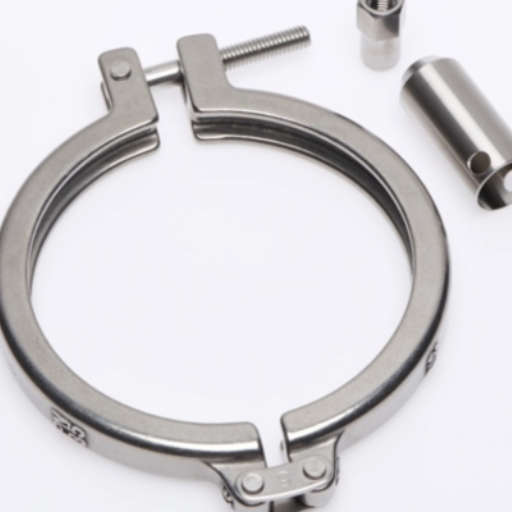
In order to maintain stainless steel systems in a sanitary condition:
- Regular Cleaning: The complete system has to be cleaned using the correct cleaning products, such as approved mild detergents or deodorizing sanitizers. Avoid using abrasive cleaners, as this may result in surface damage.
- Inspect for Wear and Tear: Regularly check the system for signs of damage, corrosion, or pitting to make sure that it is working and the system is intact.
- Use Proper Tools: Use the right cleaning materials by employing non-abrasive tools and soft brushes on the surface steel finish.
- Follow Manufacturer Guidelines: Operate as instructed by the manufacturer with regards to scheduled cleaning, and maintenance cadence as recommended by the equipment manufacturer.
- Ensure Proper Storage: The stainless steel components should be kept dry and clean to eliminate the chances of contamination from moisture when not being used.
Lack of consistent hygiene practices will result in the system losing its integrity, performance, and compliance with sanitary standards.
Cleaning and Sanitization Protocols
Sanitary valves and process components are fundamental in the food and beverage, biotechnology, and pharmaceutical industries, which require the highest levels of hygiene and accuracy. Such components are manufactured to comply with the FDA and 3-A Sanitary Standards’ rigid requirements of sanitation. There are various types of sanitary valves, such as butterfly valves, diaphragm valves, and ball valves, which each serve unique purposes. Diaphragm valves, for instance, are ideal for the control of sensitive or viscous fluids because of their smooth, crevice-free interiors.
The materials used in constructing sanitary valves also include stainless steel, which is most often 304 or 316L grade, as they offer resistance to corrosion, strength, and endurance to sterilization methods such as SIP (Steam in Place) or CIP (Clean in Place). Research indicates that the structure of sanitary stainless steel components is not compromised when exposed to temperatures above 250°F (121 °C) for a prolonged period, which is beneficial for sterilization procedures. Moreover, the design of the components is precisely engineered to maintain minimal turbulence and pressure drops to ensure that the flow rates are efficient.
Parts that are used in processes such as sanitary gaskets, sanitary fittings, and tubing are equally important in sustaining hygiene. A good example would be tri-clamp fittings, which are some of the most common sanitary connectors due to how easy they are to assemble and clean. Studies show that contemporary gaskets constructed from PTFE or silicone can function under severe pressure at elevated temperatures, thus increasing the safety and dependability of the entire system. Sanitary valves, when used with other equipment designed to work with them, and various other process components ensure that the product meets the required safety standards, thus safeguarding the product’s integrity.
Preventing Corrosion in Sanitary Stainless Steel
Corrosion of hygiene sanitary stainless steel is a concern in the food, beverage, and pharmaceutical industries as it can lead to severe contamination, damage to equipment, or an increase in servicing costs. Chrome, a prominent alloying element in stainless steel, forms a passive film that protects stainless steel from corrosion; however, certain conditions like chlorides, acids, and high temperatures can lead to failure of this film.
Failure of passive film can also be mitigated by choosing the right stainless steel grade for certain applications. For instance, 316 and 316L are known to have better resistance to corrosion due to chlorides, and therefore are better suited for marine or acidic environments. Moreover, surface finishing by way of electropolishing enhances surface smoothness, thus reducing contaminant retention and enhancing pitting resistance.
Arresting surface contamination regularly, along with a frequent schedule of light maintenance, enhances corrosion resistance as well. Mild non-abrasive detergents that are neutral to pH can be used for cleaning the surface without causing scratches on the oxide film. Dried equipment after washing should be stored to prevent corrosion in inaccessible locations. Regular examinations for loose surface Inclusions or minor color change, along with small indentations, allow repair work without excessive long-term injury. Then, long-term damage and injury can be minimized by implementing regular inspections.
Data from industrial studies suggest that using these preventive approaches can increase the lifespan of stainless steel equipment by 20% and greatly lower operational costs in the long run. Moreover, the development of duplex stainless steels with higher resistance to stress corrosion cracking improves options for these industries and additional advancements in the material science work.
Reference Sources
- Identification of Surface Characteristics Relevant to the Hygienic Status of Stainless Steel:
- Key Findings: The study evaluated the hygienic status of various stainless steel grades (304, 316, 430) and finishes (pickling, bright annealed, electropolished). It found that grade and surface finish significantly influence bacterial adhesion and cleanability. Surface topography and free energy parameters were also linked to hygiene levels.
- Methodology: Used Bacillus cereus spores to test adhesion and cleanability across different stainless steel samples under simulated dairy industry conditions.
- Metallurgy and Processing of Stainless Steel:
- Key Findings: Discussed the role of stainless steel in meeting 3-A sanitary standards, emphasizing corrosion resistance, passivity, and surface finishes for food-grade applications.
- Methodology: Reviewed standards and processes, including welding and surface treatments, to enhance stainless steel’s suitability for sanitary applications.
- Stainless Steel: The Environment-Friendly Choice:
- Key Findings: Highlighted stainless steel’s safety for human health and its role in improving hygiene in the food and medical industries. Discussed the passive film’s role in corrosion resistance and the minimal release of chromium and nickel during use.
- Methodology: Combined literature review and experimental data on metal release and corrosion resistance in various environments.
Frequently Asked Questions (FAQs)
Q: What are the key characteristics of stainless steel sanitary tubes used in food processing?
A: Stainless steel sanitary tube used in food processing is characterized by its corrosion-resistant properties, smooth surface finish, and high degree of cleanliness. These tubes are typically made from 304 stainless steel or 316L for more corrosive environments. They must meet strict material requirements, including precise dimensional tolerances, surface roughness standards (usually 20-32 Ra or better), and undergo specialized cleaning processes. Food-grade stainless steel tubing is designed to prevent bacterial growth, withstand sanitizing chemicals, and maintain product purity. Every high-quality stainless steel sanitary tube must comply with industry standards such as ASTM A270 and ASME BPE specifications to ensure safety and reliability in food processing applications.
Q: What is ASME SA270, and why is it important for stainless steel sanitary tubing?
A: ASME SA270 is a specification developed by the American Society of Mechanical Engineers that establishes standards for austenitic stainless steel sanitary tubing used in the food, beverage, dairy, and pharmaceutical industries. This standard is crucial because it ensures that steel sanitary tubes maintain consistent quality and performance in sanitary process applications. ASME SA270 covers requirements for chemical composition, mechanical properties, dimensional tolerances, and surface finish. Most importantly, it specifies the rigorous testing and inspection methods manufacturers must follow. By choosing stainless steel products that meet ASME SA270 specifications, processors can be confident their sanitary pipe systems will maintain product purity and comply with regulatory requirements for food-grade applications.
Q: How does stainless steel sanitary tubing differ from regular stainless steel tubing?
A: Stainless steel sanitary tubing differs from regular stainless steel tubing in several critical ways. Sanitary tubing has stricter requirements for surface finish (typically 20-32 Ra or better) compared to standard tubing, as even microscopic imperfections could harbor bacteria. The manufacturing process includes special polishing techniques for both interior and exterior surfaces. Sanitary tubing must meet ASTM A270 specifications with tighter dimensional tolerances and undergo more rigorous testing and quality control. It’s specifically manufactured to be free from crevices, pits, or other areas where product could accumulate. Additionally, sanitary tubing is produced from specific stainless steel materials like 304 stainless steel or 316L that are verified for food contact safety, while regular tubing may use a wider range of stainless steel alloys without the same level of purity verification.
Q: What does the BPE standard mean for stainless steel sanitary tube applications?
A: BPE (Bioprocessing Equipment) standard, developed by ASME, represents the gold standard for stainless sanitary applications in bioprocessing, pharmaceutical, and high-purity food production. For stainless steel sanitary tube applications, BPE establishes more stringent requirements than even ASTM A270 standards. It specifies precise material composition, surface finish requirements (often SF1-SF6 designations), documentation protocols, and validation processes. BPE-compliant tubing must maintain exceptional corrosion resistance and demonstrate complete traceability. The standard also addresses design considerations for sanitary connections, hygienic welds, and dead-leg minimization. For tube manufacturers, meeting BPE standards requires sophisticated production methods, comprehensive testing, and documented quality systems. Food and pharmaceutical processors rely on BPE-compliant tubing to ensure product integrity, regulatory compliance, and consumer safety.
Q: What should I look for when selecting an ASTM A270 stainless steel sanitary tube manufacturer?
A: When selecting an ASTM A270 stainless steel sanitary tube manufacturer, first verify their compliance with relevant industry standards (ASTM A270 S2, ASME BPE, 3-A Sanitary Standards). Look for manufacturers with extensive experience in producing food-grade stainless steel tubing with proper certifications. Quality suppliers will offer detailed material test reports and maintain comprehensive traceability systems. Evaluate their manufacturing capabilities, including consistent surface finish control, precision dimensional tolerances, and advanced cleaning processes. The manufacturer should demonstrate expertise in corrosion-resistant alloys like stainless steel 304 and 316L. Consider their quality control systems, including inspection methods for detecting defects. Finally, assess their customer service, lead times, inventory availability, and ability to provide technical support for your specific sanitary process requirements.
Q: How does stainless steel 304 compare to other grades for sanitary applications?
A: Stainless steel 304 is the most commonly used grade for sanitary applications due to its excellent balance of corrosion resistance, formability, and cost-effectiveness. Containing approximately 18% chromium and 8% nickel, 304 grade steel provides good resistance to most food acids, cleaning chemicals, and sanitizing agents. However, when compared to 316L (which contains 2-3% molybdenum), 304 offers slightly lower resistance to chlorides and salt environments. For highly corrosive applications involving brine solutions, high-salt foods, or certain acidic products, 316L may be preferred despite its 15-20% higher cost. Other specialty grades like AL-6XN or 2205 duplex provide even greater corrosion resistance for extreme environments, but at significantly higher costs. Most standard food and beverage processing applications find stainless steel 304 to be the optimal balance of performance and economy for their sanitary tubing needs.
Q: What are the common manufacturing methods for stainless steel sanitary tubing?
A: Stainless steel sanitary tubing is primarily manufactured through two methods: welded tubing and seamless tubing. Welded tubing starts with a flat stainless steel strip that’s formed into a circular shape and welded along the seam, followed by annealing to homogenize the material. The weld is then polished to match the rest of the tube surface. This method is more economical and works well for most food-grade applications. Seamless tubing is created by piercing a solid stainless steel billet and then hot or cold working it to the final dimensions without any welds. While more expensive, seamless tubing eliminates weld-related concerns entirely. After forming, all sanitary tubing undergoes extensive finishing processes, including annealing, pickling, passivation, and mechanical polishing to achieve the required surface finish specified in ASTM A270 standards. High-quality tube manufacturers employ rigorous quality control throughout production to ensure consistent dimensional tolerances and surface characteristics.
Q: What surface finish requirements apply to stainless steel sanitary tube?
A: Surface finish requirements for stainless steel sanitary tube are critical to ensure proper cleanability and prevent product contamination. According to ASTM A270 specifications, sanitary tubing must meet specific surface roughness measurements, typically expressed in Ra (roughness average) values. Standard food-grade stainless steel tubing requires a 32 Ra or better finish on interior surfaces. Higher-purity applications like dairy processing might require 20 Ra or better, while pharmaceutical applications under BPE standards often specify 15 Ra or better with electropolishing. Beyond roughness values, the surface must be free from visible defects, scratches, pits, or crevices. Proper finishing methods include mechanical polishing, electropolishing, and passivation to enhance corrosion resistance. The finish must be consistent throughout the tube length and circumference, making quality control crucial during manufacturing. Tube suppliers should provide certification confirming surface finish measurements meet the specified requirements.
Q: How are sanitary stainless steel tubes tested to ensure they meet quality standards?
A: Sanitary stainless steel tubes undergo comprehensive testing to ensure compliance with quality standards. Material composition verification through spectrographic analysis confirms that the stainless steel meets 304 or other specified grade requirements. Dimensional inspection checks outside diameter, wall thickness, and straightness tolerances according to ASTM A270 specifications. Surface finish testing using profilometers measures Ra values to verify interior and exterior smoothness. Hydrostatic pressure testing ensures tubing withstands the required operational pressures without leaking. For higher-purity applications, ferroxyl testing detects free iron contamination on surfaces. Manufacturers may perform borescope inspections of internal surfaces to identify defects invisible from the exterior. Corrosion resistance testing through salt spray exposure or other methods may be conducted on samples. For BPE applications, additional testing for mechanical properties and material traceability is required. Reputable tube manufacturers maintain detailed documentation of all test results to provide full material certification packages with each shipment.
Q: What cleaning and maintenance practices are recommended for food-grade stainless steel tubing systems?
A: For food-grade stainless steel tubing systems, proper cleaning and maintenance are essential to maintain sanitary conditions. Implement regular Clean-In-Place (CIP) procedures using appropriate cleaning agents specifically designed for food processing environments. These typically involve alkaline cleaners for organic soils, acid cleaners for mineral deposits, and sanitizers to eliminate microorganisms. Avoid chloride-based cleaners, which can cause pitting corrosion in stainless steel 304. Establish appropriate temperatures, flow rates, and contact times based on the specific sanitary process requirements. Perform regular visual inspections using borescopes to check for residue buildup or surface degradation. Implement preventive maintenance schedules to check gaskets, connections, and supports. After any system modifications, conduct thorough passivation to restore the chromium oxide layer that provides corrosion resistance. Document all cleaning procedures and maintenance activities to comply with food safety regulations. Following these practices will extend the service life of your stainless steel sanitary tube system while ensuring continued product safety.

